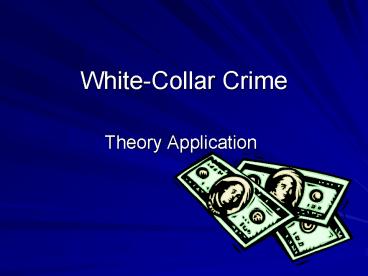WhiteCollar Crime - PowerPoint PPT Presentation
1 / 16
Title:
WhiteCollar Crime
Description:
Strain Theory. Robert K. Merton 1938. Cultural system with ... Inability to acquire the goals results in strain. Merton's 5 Individual. Modes of Adaptation ... – PowerPoint PPT presentation
Number of Views:80
Avg rating:3.0/5.0
Title: WhiteCollar Crime
1
White-Collar Crime
- Theory Application
2
Differential AssociationEdwin Sutherland
(1883-1950)
- Criminal behavior is learned
- Learned in interaction with others
- Learning occurs within intimate personal groups
3
Differential Association
- The learning includes
- techniques of committing the crime
- direction of motives, drives, rationalization
- Directions of motives and drives learned from
definitions of legal codes as favorable or
unfavorable - Delinquency occurs because of an excess of
definition favorable to violation of law
4
Differential Association
- Learning process involves same mechanisms that
are in involved in other learning - Differential associations may vary in frequency,
duration, priority, intensity
5
Techniques of NeutralizationSykes Matza
- Denial of Responsibility
- Denial of Injury
- Denial of the Victim
- Condemnation of the Condemners
- Appeal to Higher Loyalties
6
(No Transcript)
7
How Doctors Defraud MedicaidJesilow, Pontell,
Geis
- Blamed patients, hospitals, labs, or other
medical professionals. Illegal activities were
mistakes. - Breaking the law meant that they were helping
patients. - Admit wrongdoing, yet state that they harmed no
one. - Blame confusing regulations and bureaucratic
obstacles.
8
Strain TheoryRobert K. Merton 1938
- Cultural system with approved values and goals
- Acceptable norms for achieving the goals
- Inability to acquire the goals results in strain
9
Mertons 5 Individual Modes of Adaptation
10
Social Bond TheoryTravis Hirschi
- Why dont we commit crime?
- Internalization of law-abiding norms or
development of social bonds. - The identification of motivation is secondary.
11
Social Bond Theory
- Weakened or broken social bonds reduce a persons
stake in conformity. - The weaker the ties the more likely deviance is
to transpire.
12
Social Bonds
- Attachment
- Commitment
- Involvement
- Belief
13
A General Theory of Crime (1990)Gottfredson
Hirschi
- crime is the natural consequence of
unrestrained human tendencies to seek pleasure
and avoid pain.
14
According to Gottfredson Hirschi
- Variations in self-control can account for
proclivities to commit criminal acts. - Low self-control increases the likelihood of
aberrant activity.
15
Elements of Self-Control
- Criminal acts provide immediate gratification
- Easy gratification of desires
- Crime is exciting, risky, or thrilling
- Unstable lifestyle
16
Characteristics of Low Self-Control
- Impulsive
- Insensitive
- Physical
- Risk-taking
- Short-sighted
- Nonverbal































